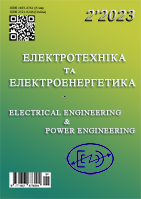Improving the quality of the stabilization of the output current of the pulse dc converter operating on a plasma arc
DOI:
https://doi.org/10.15588/1607-6761-2023-2-1Keywords:
stabilization quality, DC pulse converter, plasma arc, combined controlAbstract
Purpose. Improving the quality indicators of control processes for pulsed DC converters operating on an arc load, based on the construction of procedures for the synthesis of robust systems.
Methodology. A method of improving the quality of stabilization of the output current of a pulsed direct current converter based on a combination of disturbance control with control of the output current deviation from a given value (localization method) is considered.
Findings. The article deals with the solution of the optimization problems of the output current stabilization system of the pulsed direct current converter feeding the plasma arc under, among other things , stochastic external influences in connection with the problems of non-roughness and strict implementation of optimal regulators and the solution of optimization problems according to the quality of invariance. Methods for constructing optimal controllers are considered and the possibility of solving the optimization problem by the invariance property is established. Examples of solving deterministic and stochastic optimization tasks are given, taking into account the properties of roughness, structural and strict implementation of the stabilizing regulator.
Better accuracy of arc current stabilization in statics and dynamics is provided, which is confirmed by simulation modeling. The quality of arc current stabilization is achieved when using control systems based on the quality of invariance and solving optimization problems in the class of "good" regulators built on the basis of the localization method. Regulators calculated on the basis of the correlations of the localization method provide the required quality of the processes and have the property of roughness (robustness) in relation to the deviation of the object parameters from the nominal values in a wide range. If the object contains non-stationary parameters or its properties are not fully known, in this case it is better to use the localization method to calculate the controller.
Originality. We received further development of the procedure for the synthesis of optimal regulators and methods of solving optimization problems by the property of invariance.
Practical value. On the basis of the method of combined control and the concepts of localization, the optimal laws of control of free and forced movements of a one-dimensional system are synthesized. The latter, however, has the property of rudeness. The efficiency of the synthesized algorithms is illustrated by the results of mathematical modeling.
References
Jia Deli, You Bo, Zhang Xueyan On Fuzzy-PI Control for Inverted Plasma Cutting Power Supply. Proceed-ings of the 27th Chinese Control Conference July 16-18, 2008, Kunming, Yunnan, China. – P. 335-339.
Jia Deli, You Bo An intelligent control strategy for plasma arc cutting technology. Journal of Manufac-turing Processes 13 (2011). P. 1–7.
Guoping Li, Qi Cao, Yujian Fu Research on Current Control Technology of Fine Plasma Cutting. Interna-tional Symposium on Mechanical Engineering and Material Science (ISMEMS 2016). Volume 93. P. 380-386.
Voronov A.Yu., Gerasimov V.A. Regulation of the com-pressed arc current in the plasma torch channel, Bulletin of the Tomsk Polytechnic University, 2011, T3, №4, pp. 313-135.
Voronov A.A. Fundamentals of the theory of auto-matic control. Part 1. Moscow, Energy, 1965, 362 p.
Besekersky V.A., Popov E.P. Theory of automatic control systems. Moscow, Nauka, 1975, 768 p.
Vostrikov A.S. The problem of synthesizing controllers for automation systems: state of the art and pro-spects, Avtometriya, 2010, V.46, №2, pp. 3-19.
Vostrikov A.S., Frantsuzova G.A. Theory of automatic control. Moscow, Higher school, 2nd ed., 2006, 356 p.
Vostrikov A.S., Utkin V.I., Frantsuzova G.A. Systems with the derivative of the state vector in control, Au-tomation and Telemechanics, 1982, №3, pp. 22-25.
Komarov N.S. Power supply devices for powerful arc heaters for waste gasification plants, Technical elec-trodynamics, 2009, №1, pp. 70-76.
Ulanov G. M. Statistical and informational issues of perturbation control, Moscow, Energy, 1970. 255 p.
Meerov M. V. Synthesis of structures of automatic control systems of high accuracy, Moscow, Nauka, 1967, 423 p.
Kukhtenko A. I. The problem of invariance in auto-mation, Kyiv, State. Publishing house of tech. litera-ture, Ukrainian SSR, 1963, 376 p.
Phillips Ch., Harbor R. Feedback control systems, Moscow, Laboratory of basic knowledge, 2001, 616 p.
Krutko P.D. Inverse problems of dynamics in the theory of automatic control, Moscow, Mechanical engineering, 2004, 576 p.
Vereshchago E.M., Kostiuchenko V.I. Modeling of circuits for electrically driven arc welding in MATLAB / SIMULINK // Electrical Engineering and Power Engineer-ing, 2021, №3, pp. 8-20. DOI: 10.15588/1607-6761-2021-3-1
Downloads
Published
How to Cite
Issue
Section
License
Copyright (c) 2023 Євген Верещаго, Віталій Костюченко

This work is licensed under a Creative Commons Attribution-ShareAlike 4.0 International License.
Creative Commons Licensing Notifications in the Copyright Notices
Authors who publish with this journal agree to the following terms:
Authors retain copyright and grant the journal right of first publication with the work simultaneously licensed under aCreative Commons Attribution License that allows others to share the work with an acknowledgement of the work's authorship and initial publication in this journal.
Authors are able to enter into separate, additional contractual arrangements for the non-exclusive distribution of the journal's published version of the work (e.g., post it to an institutional repository or publish it in a book), with an acknowledgement of its initial publication in this journal.
Authors are permitted and encouraged to post their work online (e.g., in institutional repositories or on their website) prior to and during the submission process, as it can lead to productive exchanges, as well as earlier and greater citation of published work.

